I have been traveling, or here at Krell House in Northern Arizona, since 24 December of 2011, and have had virtually no access to the Internet, or to long distance telephony during that time. Additionally, communicating with the world via Chronosphere or email have been comparatively low priorities.
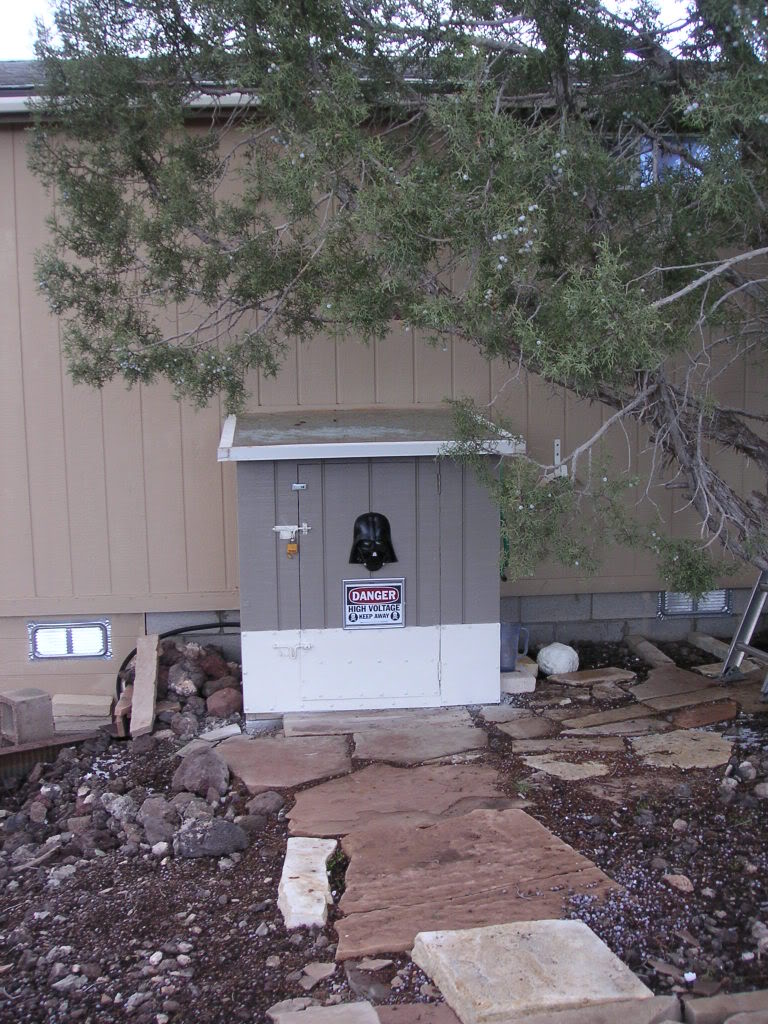
The extreme daily hysteresis in the ambient temperature and humidity in Northern Arizona rapidly degrades coatings and causes the underlying structures to fall to ruin. One example of what I am doing to defend against this is to protect high damage areas of buildings with FRP (fiberglass reinforced paneling) treated with a UV protective coating (photo above). I might also add that these conditions make the use of nails in wood construction inadvisable. Within the space of a year nails, even under painted surfaces, will be extruded ~2-3 mm from the lumber they are embedded in. After ~5 years, they may have backed out of the wood so much as a result of the relentless daily cycles of expansion and contraction (of the wood) that they simply fall out! Screws and glues are the only way to build here.
I arrived in Arizona to find serious damage to the roof of my home, as well as a large number of deferred maintenance tasks crying out for completion. I also discovered that the phone/internet access cable to my home, as well as the fiber optic trunk, had been accidentally attacked by a neighbor’s backhoe. In fact, over 100 ft of phone cable had been uprooted from the ground and requires reburial – a task I’m attending to now.
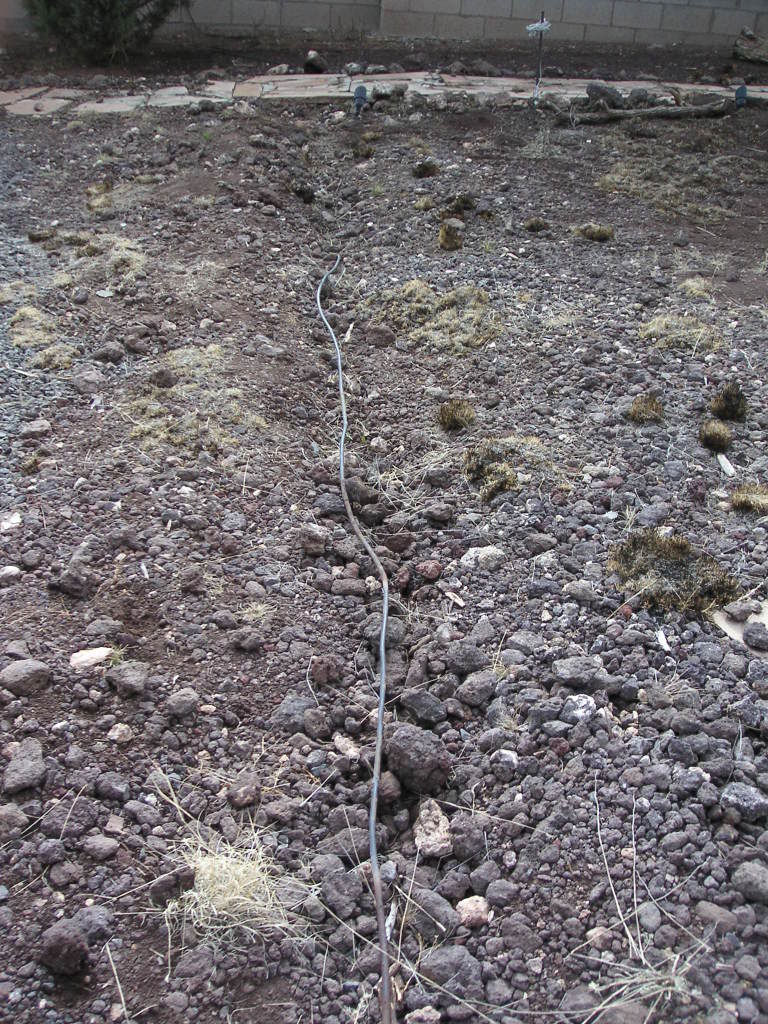
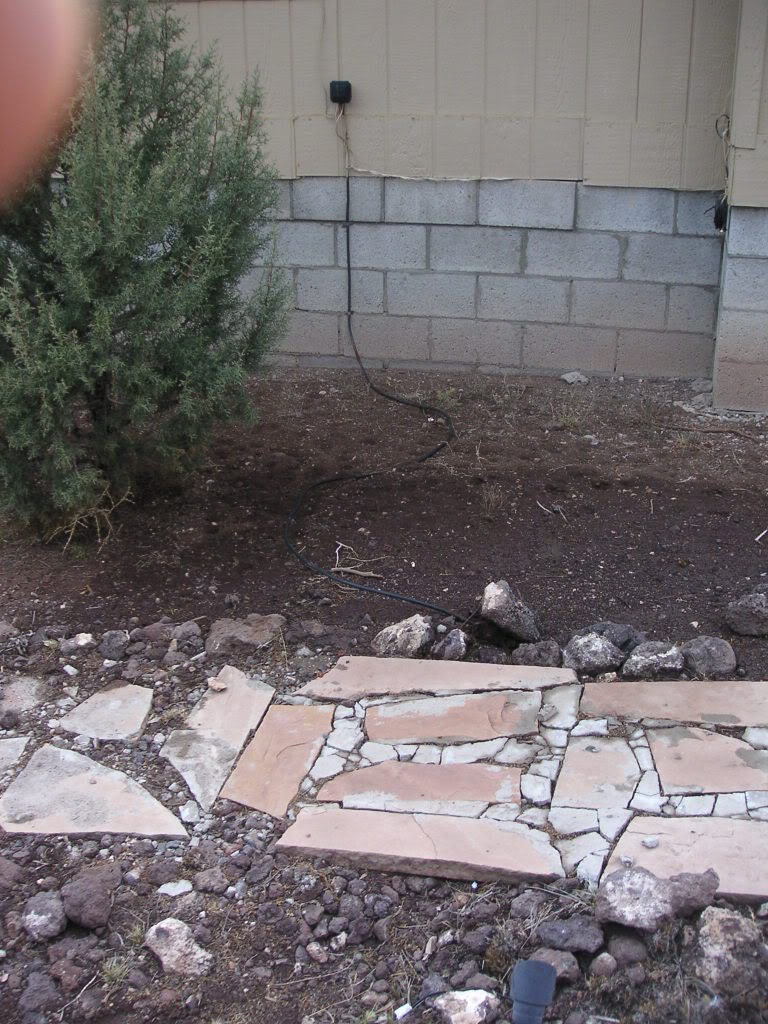
The telephone cable to my home was uprooted from a point on the adjacent property right up the junction box where it enters the house.
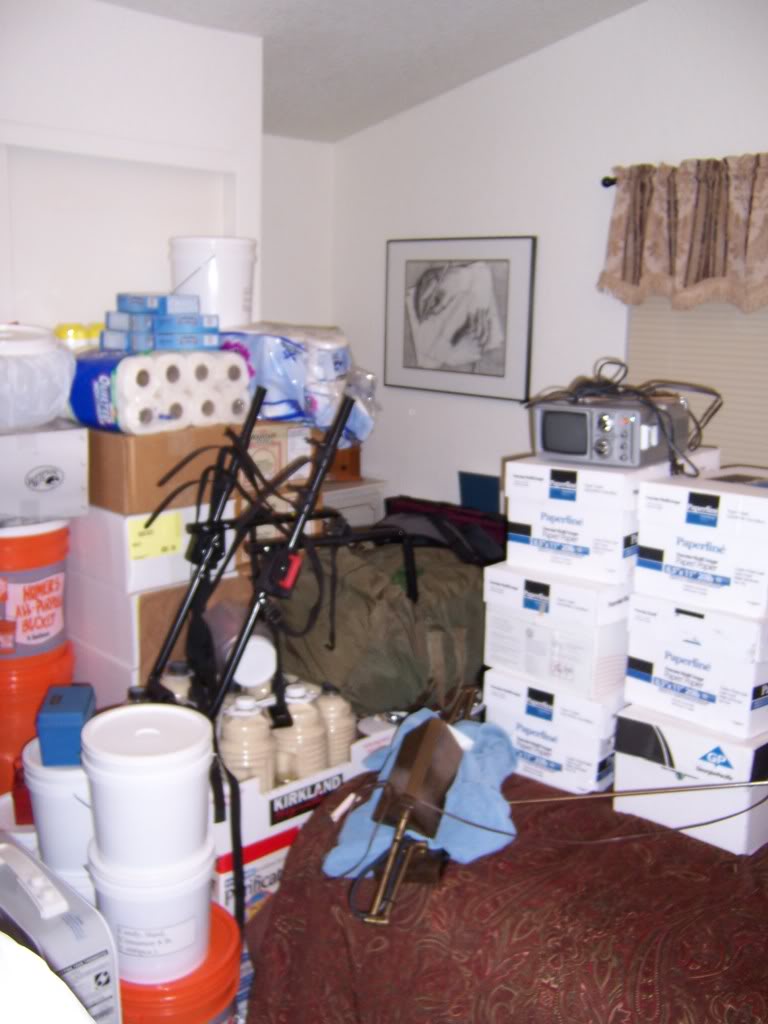
Added food, emergency lighting, and other reserves (above).
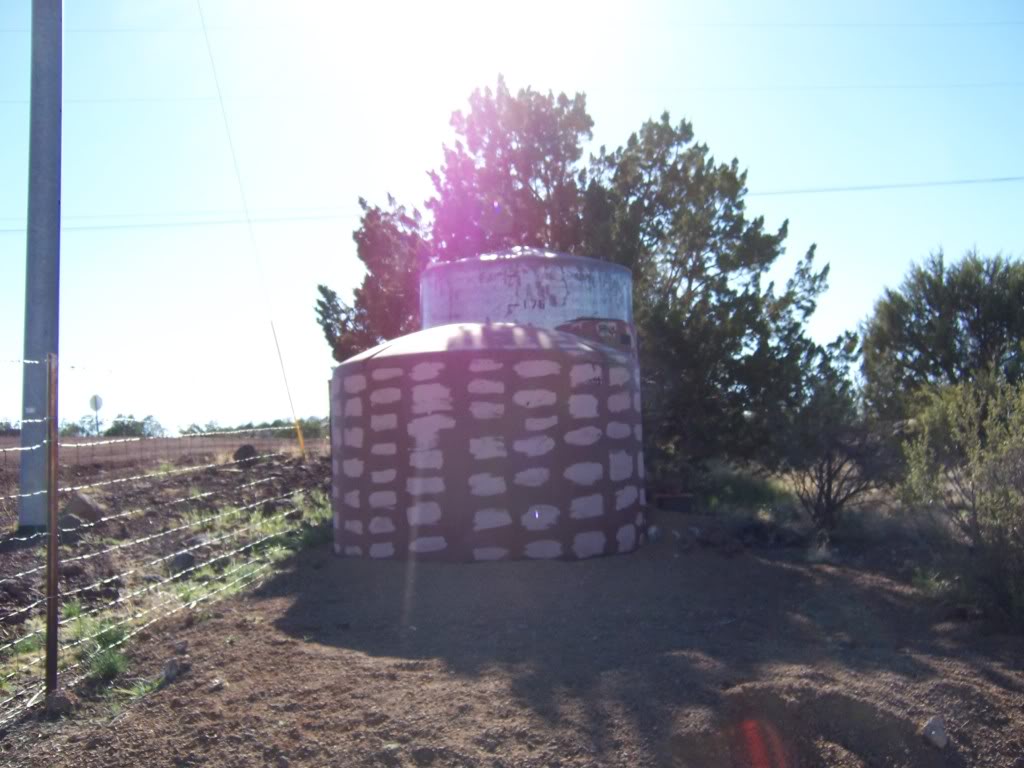
An additional 1,000 gallons of water has been brought on line and connected to the house pumping system (above) for a total capacity of 3,000 gallons.
As the world economic and political situation continues its decline I am also increasingly working to prepare for the likelihood of even harder time ahead. I have increased long term food reserves, added an additional 1,000 gallons of water storage capacity and implemented a crude rainwater collection system.
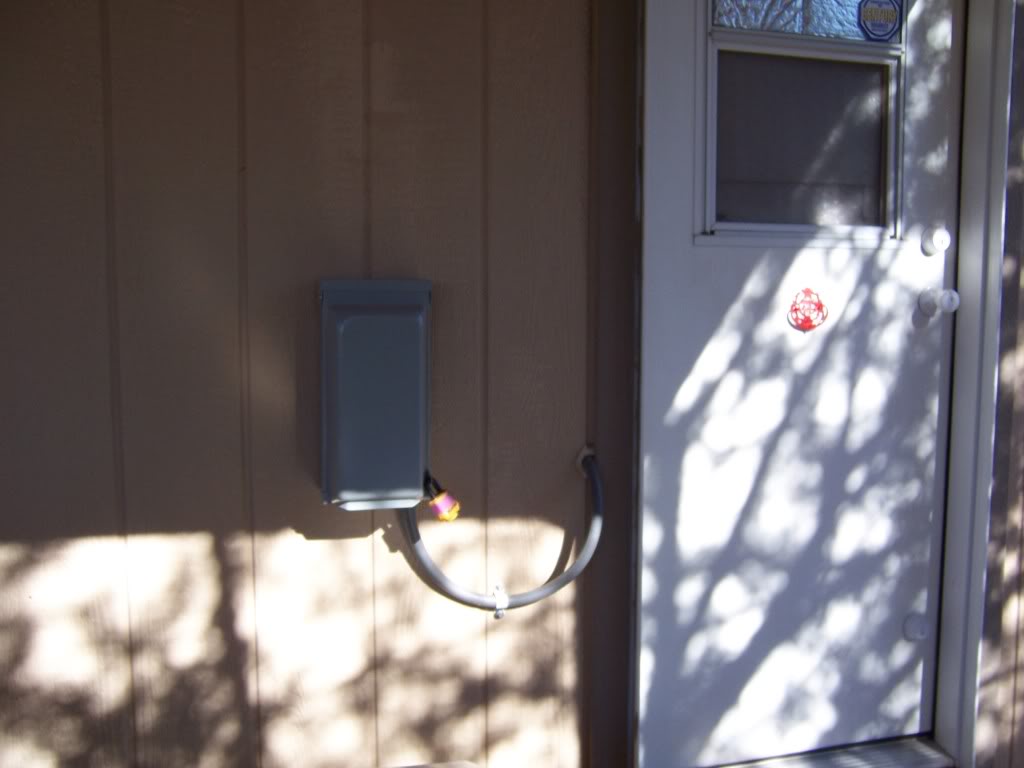
Generator,house power interface (above).
I’ve also completed installation of the back up generator switchover system which allows a seamless (and safe) transition of the house from grid to 5 kw of generator power. I am currently working on the support systems for a small (~ 250 watt) solar panel/battery bank system (battery house, charge controller and inverter)
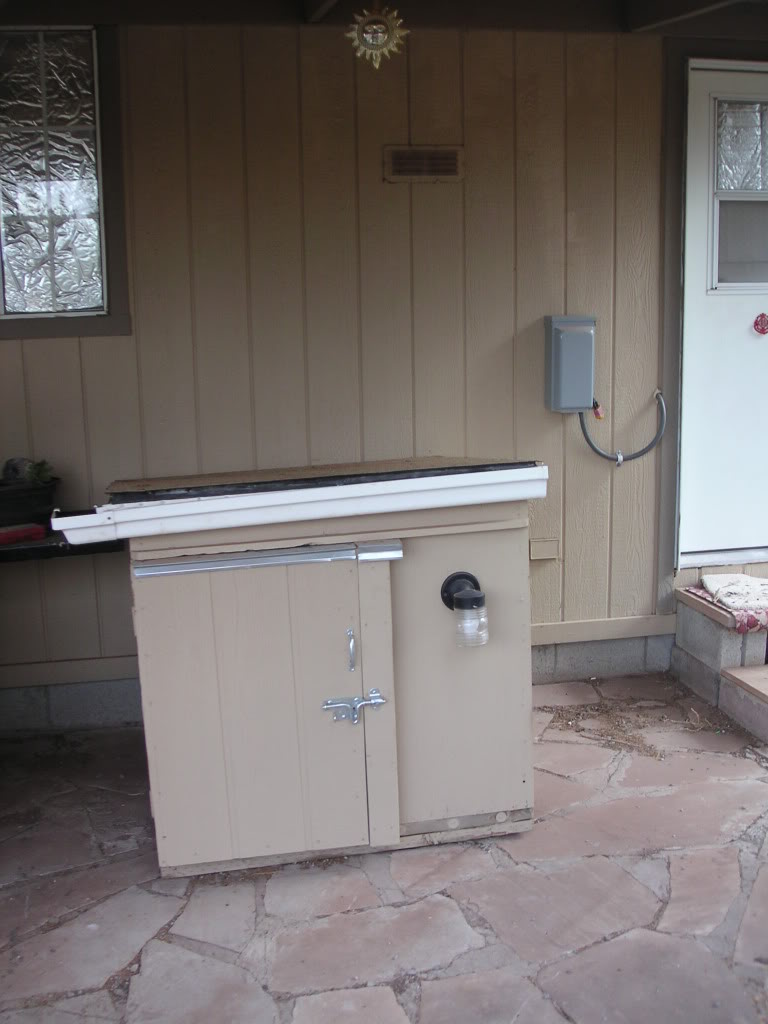
Heavily insulated and heated battery shed.
Another high priority has been to create the infrastructure required to allow year round cultivation of greens and root vegetables. As a child, I was responsible for maintaining our two “hotbeds” which provided our family with Bibb lettuce, Musclun, bunching onions and salad lettuce for most of the winter. That system relied on fermenting manure in a glass covered wooden frame that was largely buried in the ground to provide both heat and fertilizer.
Unfortunately, the large hysteresis in daily temperature here, coupled with the presence of abundant sunlight, creates real problems for that system of cultivation absent nearly constant attention. Ambient temperature typically fluctuates between 50 to 60 degrees F during the day, to as low as the teens or low 20s at night. Days are often cloudless and bright which means that the temperature in any kind of glassed-in enclosure could easily and rapidly exceed 120 degrees F! Thus, such an enclosure would have to be opened and closed at least twice a day; with any failure to do so likely resulting in the loss of the crops.
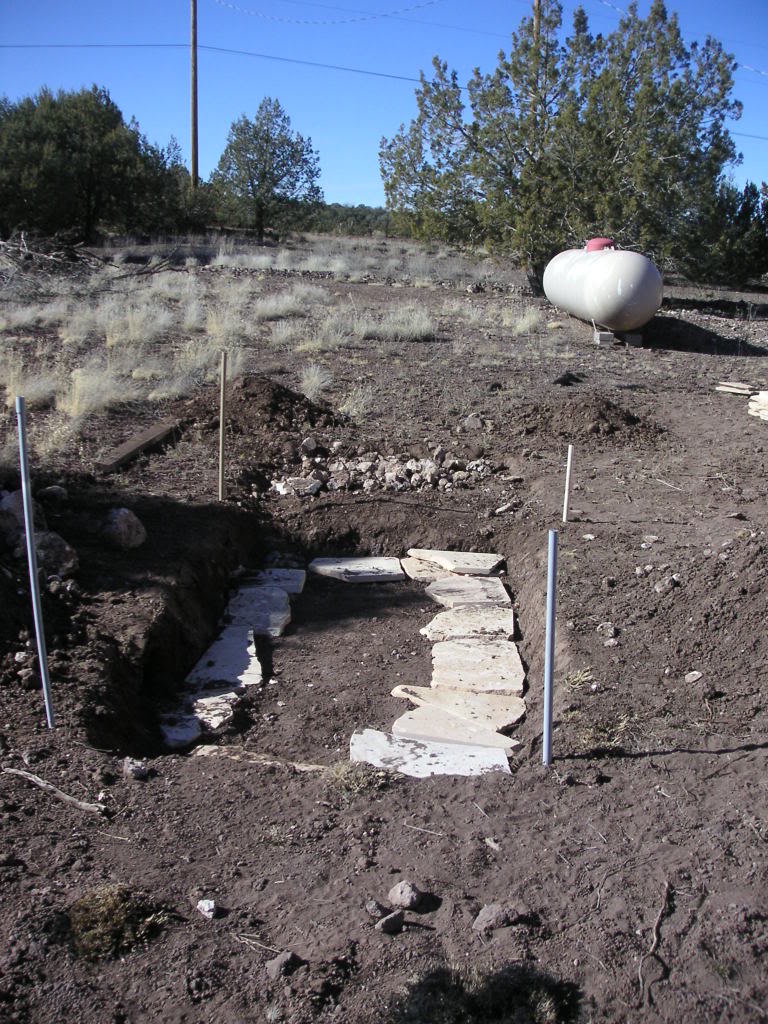
Initial excavation and stone-laying of the cultivation chamber. The tank visible in the background is a 1,000 gallon propane tank.
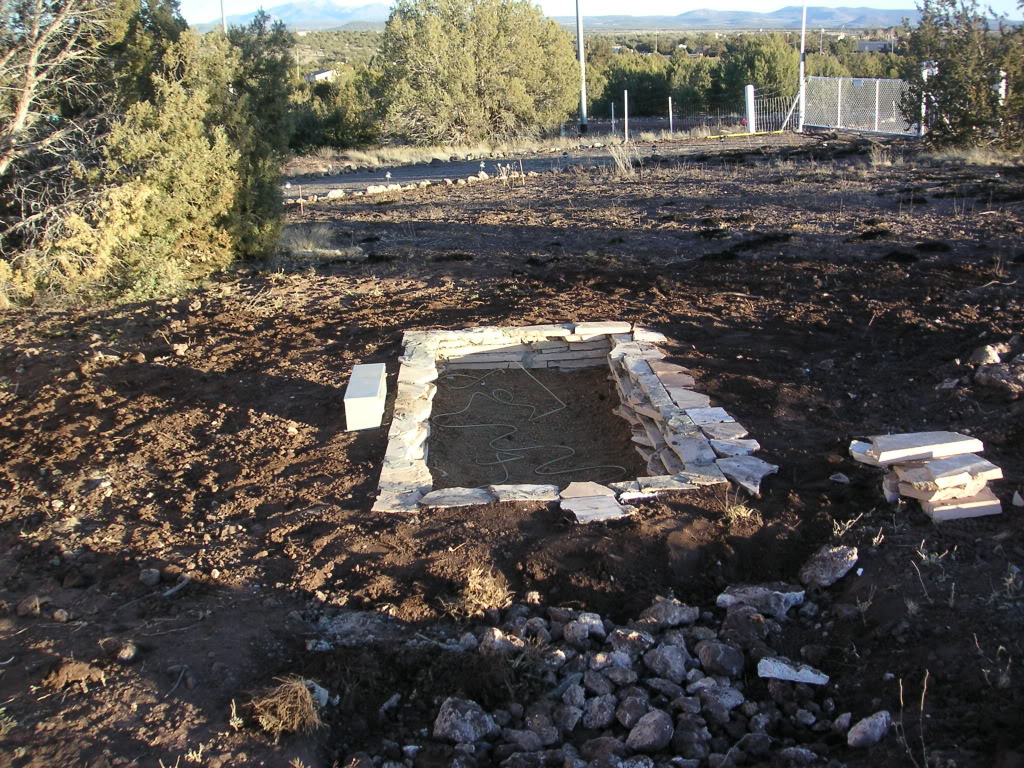
Nearly completed stonework with finished grading.
Until very recently, scrap Kaibab stone was available free here. Even now, it is only $20.00 for a level pick-up truck bed full. This has allowed me to construct a large, well insulated, earth sheltered and heat-sink protected cultivation chamber.
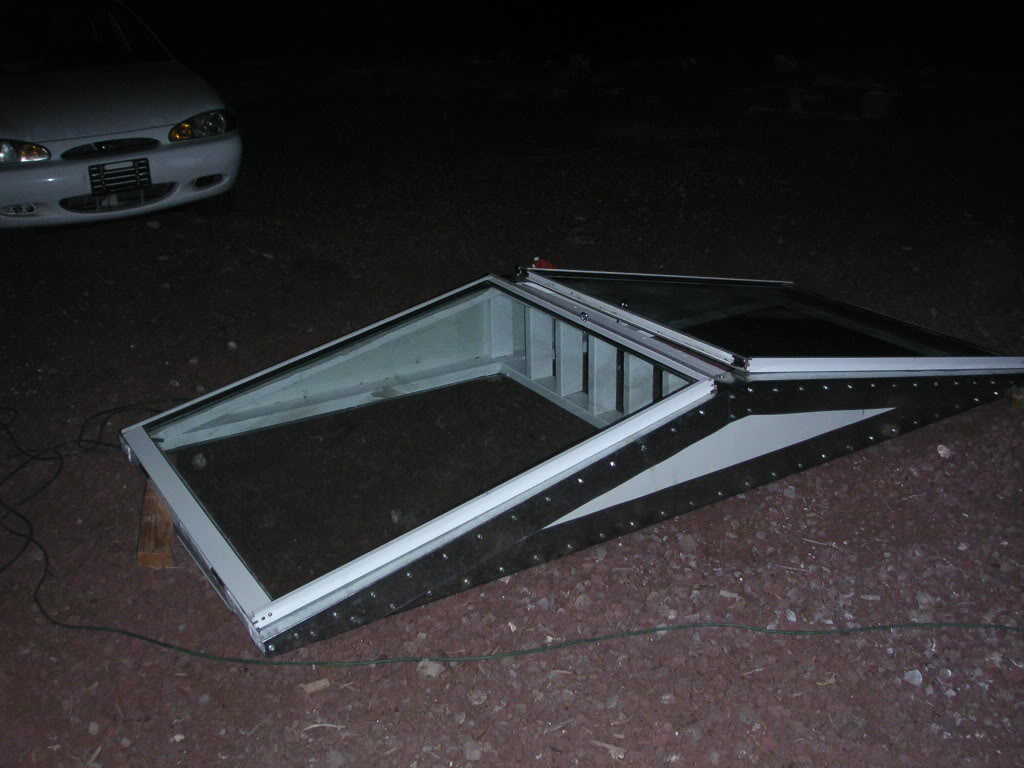
Construction is well underway on the sunlight admitting glass and environmental module that will be bolted to the stonework. The cross members seen in the photo above will soon be decorated with an automatic, solar powered climate control system. When the internal temperature exceeds the safe limit, a muffin fan is activated to bring in cooler air from the outside. In the summer, cool, moist air is generated and delivered via an underground network of pipes that also uses evaporative cooling. Watering is also automatically controlled. The entire set up was built to be resistant to penetration by radionuclides. This is a far more difficult challenge than keeping a stock of soil protected (which can be done quite simply by using earth covered tarps).
This project has been an especially high priority for me because it is no longer economically possible for me to have access to fresh greens, or similar, highly perishable vegetables. I live an hour’s drive from any affordable shopping of this kind, and the prices of these items has also skyrocketed. With consumer petrol prices predicted to be near $5.00 per gallon by this summer, I will have to reduce resupply trips from every two weeks to once a month – and possibly longer. I believe that the prolonged absence of this kind of food from the diet is a serious health risk – as well as being an added misery.
Another food related project is the construction of a chicken enclosure…

Heat wasting windows have been “replaced” with high grade insulation and firewood stores have been increased (above). The porch light is a high output, high efficiency LED bulb (60K hour life) brought back from Europe along with a suitcase full of others! The yellow coating was done by me.
Wood, like stone, is abundant here, and for a small fee to the Forrest Service it is possible to cut a great deal for the cost of the time, gasoline and wear and tear on the chain saw. I have thus increased my firewood reserves, and plan to increase them further. Sometime ago I “eliminated” all the windows in my home, or more properly, heavily insulated them with expanded polystyrene and fiberglass faced with a double sided, multilayer reflective heat barrier. This has reduced heating and cooling costs by over 90%. I am staggered at the massive amount of heat leak that occurs through so called “energy efficient” double pane windows. Most people aren’t in their homes during the daytime and when they are they are usually watching TV or on the computer. LED lighting is now so cheap (in Europe) that it is vastly more economical to light your home with electricity and dispense with energy gobbling windows altogether. If you need to look outside – well, that’s what cameras are for – and they can see in the infrared too, which means you can see what’s going on in the dark.
Chronospohere, at least as it has been pursued so far, has failed to gain traction. I will explore what I think are the reasons for this at a later date.
For the present, I am busy and productive and working within my (small) resource constraints. Progress is slow because almost everything I do is on a no cash basis using items recovered from the waste stream, bartered for, or purchased as scrap for one cent on the dollar (or less). It is also slow, since I am doing it myself and learning as I go along. I am blessed with a good library of books on everything from electrical wiring to woodworking. The only books thrown out more consistently in the UK and the US than the Bible are ‘self help’ and ‘how to’ books. I am becoming increasingly convinced that many people buy such books with the expectation that merely owning them will somehow magically confer mastery of their contents. Probably the same is also true of the Bible.
I am attending to the large backlog of personal correspondence that has accumulated during my period of enforced isolation from the Internet, so, if you have written me, I apologize for the tardiness of my response in advance. — Mike Darwin

You are sounding a lot like a survivalist. Is that your current direction? Food and energy independence? How does that fit in with cryonic survival and a potentially Utopian future? In a failed state, how would cryonics survive?
My current direction? It has always been my direction. Cryonics is just one component in surviving indefinitely. When Jerry Leaf and I were at Alcor, Alcor had a large cache of food, water, medical supplies, emergency communication gear and weapons on the premises in 55 gallon steel and plastic drums. Any why wouldn’t we? We were located in an area at risk for earthquakes and we were (and are) embedded in an incredibly complex and interdependent technological civilization which is highly vulnerable to single point failure. I was mentored by cryonicists like Curtis Henderson and the Chamberlains. Curtis had a bomb shelter, built quite reasonably during the Cuban Missile Crisis (Carribean Crisis in the Russian speaking countries): http://chronopause.com/index.php/2011/02/07/thus-spake-curtis-henderson/ and the Chamberlains were acutely aware of and reasonably prepared for the contingency that catastrophic decompensation of this civilization could occur with little advance warning.
How could any sane, reasonable person think otherwise?
There is a new program on the National Geographic Channel called “DOOMSDAY PREPPERS” http://yourlife.usatoday.com/health/story/2012-02-06/Doomsday-Preppers-highlights-extreme-survival-techniques/52993468/1. I find it equally amusing that these people are obsessed with surviving events that have a TINY probability of representing any threat to them (such as super volcanoes), whilst being oblivious to the CERTAINTY that they are going to die from aging and disease. It’s really crazy – and probably represents a displacement of their fear of death and their lack of control over their destinies.
Rationally, cryonics and preparedness for catastrophic events are two sides of the same coin. You don’t know when you are going to die from aging, accident or disease, and you also don’t know when (or how) you might be killed by existential events. However, given enough time (and lack of proper preparation) you WILL be killed by one or the other. Cryonics is acutely dependent upon the continued uninterrupted function of technological civilization. Any examination of history makes this seem extremely unlikely. Thus, for cryonics to seem (and indeed to be reasonable) it must address survival through the most serious (immediate) and pressing existential risks.
One reason contemporary cryonics seems so incredible to so many is that it has failed to address the massive elephant in the room: that of of geopolitical, economic and environmental instability. Most reasonable people know, in the back of their head,s if not more overtly, that shit happens, and that global destabilizations of the magnitude of WWI or WWII come along at very short intervals, when compared to the timescale required for cryonics to succeed. — Mike Darwin
“I find it equally amusing that these people are obsessed with surviving events that have a TINY probability of representing any threat to them (such as super volcanoes), whilst being oblivious to the CERTAINTY that they are going to die from aging and disease. It’s really crazy – and probably represents a displacement of their fear of death and their lack of control over their destinies.”
Well said…but I had you pegged for one of their ilk not long after browsing through the wealth of back issues of Cyronics, when colleagues openly (and perhaps affectionately at the time) called you “paranoid.” At the time, I suddenly remembered an episode of “Doomsday Preppers” featuring a man who had turned his California ranch into an arsenal, a fortress complete with booby traps and a last-resort spider hole. He’d also taken to mentoring young fans of his on such practical life lessons as being able to jump onto a moving vehicle while simultaneously laying down suppressing fire. I thought “Holy shit, I’ll bet Mike Darwin has something like that going on.” Came across this page (as I continue my daily perusal of your wonderfully rich and informative blog), and it turns out I was right (sort of).
Preparedness is a virtue, and “better safe than sorry” is a sturdy if not well-worn maxim.
However…
“Cryonics is acutely dependent upon the continued uninterrupted function of technological civilization. Any examination of history makes this seem extremely unlikely.”
It seems to me that this is assessment is only valid beyond the provincial level on time scales in excess of current human life expectancy in the western world; any examination of history bears this out.
It also seems to me that the complexity and interdependent nature of our current civilization necessarily limits the potential severity of any single point failure…relative, at least, to civilizations of the past. The 2008 financial meltdown is a case in point; the relative (short-term) success of the Chinese government to soften the blow probably helped buoy multinational corporate infrastructure more than any single act that was politically feasible for *any* US government (ie right or left). Of course, whether it turns out that China merely delayed the inevitable and is in fact heading towards a new crisis of its own making remains to be seen (*though if it is* it too will be buoyed in kind by the very vested nations that would stand to suffer in the wake of a new China crisis). Spain and Greece are not dissimilar examples, their problems dragging down the EU while the very vested European economies spend the capital necessary to keep these nations from outright destruction.
Civilization is not software; the impact of catastrophic shortfalls in one region of the world are counter-balanced by local rationing and either foreign aid or the equivalent of extortion. Nevertheless, because any region of the world has some dependence on the well-being of any other region of the world, they *necessarily* have a vested interested. The late 20th and early 21st centuries have so far seen nations act in exactly this way as they leverage geopolitical power in attempts to supplant the old post-WWII hierarchies.
Obviously I realize that this may change. Interdependence might prove to be an irreparably corrupting force, whether among corporatists or financial traders…or civil/military leaders in nations that lack strong democratic institutions (ie Africa, the Middle East). New technologies may bring about unforeseen paradigm shifts, the scope of which might be difficult to appreciate as they unfold. Of course, new technologies might also bring about potent new threats.
Nevertheless, short of natural disaster or nuclear terrorism, my hunch is that the next 100 years will be as *relatively* stable for most Americans living within our borders as the last 100 years was. …and let’s be clear, the last 100 years was remarkably stable in relative terms for your centenarian Uncle Goober who lived out his humble life in Podunk, USA…and that despite an epic flu pandemic (spanish flu), natural disasters (dustbowl) economic abyss (depression), the two largest armed conflicts in human history, and several decades’ worth of the threat that a cold war could become hot.
Aside perhaps from the Spanish Flu, life and death for the vast majority of Americans has been remarkably stable and predictable since the end of the Civil War.
Nevertheless, I agree that it’s good to be prepared.
I can tell you why Chronopause has so far failed to gain traction: you’re covering an area of intense interest to only very few people, and there’s no effort spent to integrate the infrastructure in the usual web broadcast media like facebook, twitter, and sundry others — there is even no blogroll.
Obtaining visibility would require a sustained posting pattern, reaching out into other media (podcast, youtube videos) and continuous pushing to high-visibility locations.
It would require 2-3 helpers which would help with boosting visibility. I think such people can be recruited — I’m always available.
Large UPS can often be found quite cheaply on the Internet at sites such as eBay. They are cheap because site clearance companies have to take them away when companies go bust, and if they can’t get rid of them regulations mean that they have to pay a lot of money to dispose of the batteries. When there is a power outage, they can power a house for over 24hrs. If the diesel or gas generator is connected to the input, the UPS will keep going and provide stable voltage and frequency to the house.
Your scavenging practises may enable you to get one for free or very little from a local site clearance company who can’t be bothered with trying to sell it, but you would need some means of collecting it. Be careful with the batteries, as although 12v is quite safe, 200V DC or more isn’t when they are connected in series. There are usually jumpers at the front of the battery cabinet that can be removed first so that it is broken down into 48v blocks, reducing the risk of paralysing shock.
In 2000 I, purchased a top of the line 5,000 watt Honda gasoline powered generator. It still has zero hours on it, ands I have a smaller 1.5 kw Craftsman generator as well, so a UPS isn’t a high priority.
In terms of power, my highest priority is to get solar panels and batteries – neither of which I can afford to buy. As of 2008, about 1200 – 1700 people lived in this area, and of those, about 1,000 were off the grid – necessarily relying on solar power for their electricity. My guess would be that perhaps ~100 people hereabouts have no electricity at all, and get by with Aladdin lamps, candles and conventional kerosene lamps. Solar panels are thus highly prized. The same is the case in Yucca Valley, CA where there are a lot of people living off the grid. Everyone I know well here is off the grid – most moved here for affordable acreage years ago; and the reason it was affordable was because there was and is no accessible electricity (or water). You can squeak by on ~250 watts of solar panels here if you live like we do. That means no appliances with a heating element of any kind, and only very, very careful use of a vacuum cleaner during daylight hours. Basically, electricity is used to power lights, TV, satellite receiver, computer, and very low draw small appliances. If you want toast – you make it on the hob. Most folks use their wood stoves for heating water for bathing and for hot water for tea and coffee. My guess is that the population is way down from 2008 – perhaps by as much as 30 to 50%.
I have a commercial switchover system from grid to generator that was made by Generac. This also prevents me from accidentally electrocuting any utility workers who may be working on the line while I am on generator power. Because the US has historically been home to survivalists and doomsday cults, large and small, UPC and similar equipment come dear here. Consider that two of our minority religions, Seventh Day Adventistism and Mormonism are “end of time” religions. The major manufacturers of long shelf life food are all Mormon owned companies and most of what we know about the edibility of long=term stored food is due to Mormon investigators. — Mike Darwin
Good to see you back, and good to see you surviving.
Thanks. — MD
Hi Mike…I enjoy Chronosphere….here on the farm in Australia I have a wireless connection to my computer, and by climbing the hill with a thermos of coffee can have an internet cafe. Interested to see how you are travelling, and enjoy your thoughts…looking forward to more postings….Cath
Hello, Cath. It is good to see you posting.
I’m glad you enjoy it. Coming from you, that is high praise, indeed!
As I finished up editing the micrographs for the 1980s cat study, memories of Thomas came flooding back. I think of him often and I miss him terribly. His departure left a gaping hole in cryonics which has not been filled these many years later. His was a first class mind – no – a paradigm changing mind, and one that served as a rudder to keep us all on course. As I labeled the micrographs of the brain, I wondered how he would have responded to the (now) emerging tyranny of the “connectome” as the be all and end all of personal identity? [Shades of the tyranny of Nanotechnology!] Thomas was something very rare in a speculative scientist and thinker; he always considered the system as a whole and he was loathe to latch onto “simplifications” to explain evolutionarily ancient and complex phenomena, such as memory. While I am skeptical of his particular ideas about the neuronal (e.g., non- or extra-synaptic) basis of memory, I think he was very likely on point on including that we be both cautious and thoughtful in speculating about how and where memory and personality are encoded in the brain.
A few weeks ago, I scanned the photos of the training session that you and Thomas hosted at your home in Northern California. Many good memories and a few raucous laughs came back to me. Thank you both for those – and especially thanks to you – since most of the burden of hosting that gathering fell on you.
Your brief email gives the impression of a someone who is in a peaceful place – and who is content. When I think of you, which is more often than you might imagine, I always see you looking out on a stand of gum trees after a rain – the tree trunks and bases coasted in foam from the sap and the rain and the air fresh with promise of another sunny day to follow.
Be well and be happy. — Mike Darwin
Thanks Mike….The last stages of Thomas’s first life cycle and his trip to Arizona knocked me about terribly, apart from guilt and my own illness, I had the lingering delusion he was still alive, but my bipolar illness did not settle for some time, and even reading his writings and dealing with his possessions caused havoc, so I did what I could, but I have been delusion free for a couple of years and am making headway on all his writings, biography and so on. Yes, his was, and will be again, a unique and rational mind. I am fortunate in having ten years of weekly letters and drawings from him, giving an account of his thoughts and undertakings whilst we were separated. I surely appreciate the handwritten as opposed to the e-item!
I own 1500 acres of well-watered medium fertile cattle and sheep breeding country, currently running a hundred head of cattle and a few hundred sheep, with an angora rabbitry I have run for 15 years, harvesting, spinning and dyeing the fibre and designing garments I sell in local galleries. The house is at 950 m above sea level, and it can get very cold, and angora rabbit is about seven times warmer per weight than merino wool. Stephen is not for cryonics himself, but is mildly pro and will defend the idea if anyone attacks it. He is a stockman and farmer, so you can add to the mental picture my riding my horse Billie mustering sheep and cattle with my Australian kelpie dog I have trained. Also add in ten farm cats (the FANG Club) that control rats, mice and wild rabbits brilliantly, five more working dogs, two more horses and a bunch of chickens and you may guess the peacefulness is accompanied by a lot of animal activity, not including the abundant wildlife, deafening frogs, crickets and cicadas. We have koalas, roos, wallabies, echidnas, snakes, lizards…the lot.
This phase of my life satisfies the outdoor girl who studied zoology, and finds in breeding sheep and cattle a satisfying ongoing scientific interest. I have also had
two art exhibitions, with a third planned for August, the theme, of course, the humanistic side of science, and of course, immortalism. A feature painting will be titled “The Cryonic Suspension of Thomas Donaldson, PhD” in the tradition of the medical paintings e.g. by Thomas Eakins. These exhibitions continue my lifelong
subject matter, the basis of my Masters thesis in art, and the “cultural manifesto” I am currently writing about art, literature and immortalism…I do think the relative
lack of cryonicist-directed culture contributes to a lack of acceptance of cryonics… there should be more than the occasional novel or outsider-generated film or TV episode.
As for others commenting you are a “survivalist” I will comment more later. But for now I consider the earth is overpopulated, and accompanying this are limitations on personal freedom. Eric Kaufman in “Shall the Religious Inherit the Earth” makes a sound demographic case that people who are of fundamentalist or extreme religious views are outbreeding those with moderate religiosity, agnostics and atheists, and in my life the lobbying of right wing religious people have restricted MY freedoms, because they seem to want to interfere in other peoples lives. I support cryonicists and nonhuman biomass. The farm’s location was chosen because of favourable climatic modelling with respect to climate change and the crest of a range running through the place (little runoff from neighbours). I grow my own meat and vegetables. Another concern is the potential for serious world-wide epidemics….Since moving here I have not suffered from colds, flu or gi diseases. I admire what you are doing…..Long Life,
Cath
Cath, I understand completely when you say that “even reading his writings and dealing with his possessions caused havoc.” For me, this kind of problem is not an issue any longer, in that there seems to be a protective mechanism that simply does not allow me to expose myself to such injury. Willpower and volition have nothing to do with it – I am simply STOPPED. I suppose I should be grateful for this, but it is often inconvenient and frustrating, and it is also sometimes wounding to others who cannot possibly understand such behavior.
Your life seems good in Australia, and the ranch sounds a wonderful place. I’m glad you are finding your life productive and satisfying.
And that brings me to the most important part of this communication, by far. I am really excited by the idea of your artistic efforts with respect to cryonics a la Eakins. I agree with you completely that there is a profound lack of art and aesthetics in cryonics – and most of what is there is crudely borrowed and adapted from the culture. Since we don’t create our own vision of the aesthetics of cryonics (at least not since the 1960s), we try to adapt images from the culture, or worse still, we use their images of us – images which are both alien and inaccurate.
Beyond art directly about, or on the subject of cryonics, there is the broader issue of what kind of art committed cryonicists produce. Is it different in any meaningful way than the aesthetic of the wider culture? I suspect that it is. Many years ago, I remember seeing some of your fabric art paintings and I was simply blown away. They were fantastic renderings of texture and color that were like nothing I had ever seen before. The experience reminded me very much of the first O’Keefe painting (print) I’d seen as a young man.
Since I advocate doing, rather than just talking about doing, I’d like to invite you to write/display your work here. And if you have prints for sale, by all means put them on offer! I have grown weary of the “member profiles” that appear in various cryonics publications about “successful” people with American Ideal Lives. Yes, it’s nice to know such people have chosen cryonics – in fact, it’s important and gratifying to know that this is the case. But, now that I know it, I’d far rather read a profile on someone like Bart Kosco – a profile that explores his work and thought in depth – and relates them to his choice to become a cryonicist. So, I’d very much like to see an on-line showing or exposition from you with commentary (as may be appropriate)..
Similarly, I am acutely interested in anything you have written, or are writing about Thomas. The current generation of cryonicists have no idea, or at best a vague and distorted one, of who Thomas is and what he contributed. I was at a gathering in the UK last year and Thomas’ name came up, only to be dismissed as “a cryonics anti-nanotechnology Luddite.” I stopped the speaker (who was medically trained) and asked, “Do you know what edema is for?” He looked at me as if I was mad as a hatter and halting replied that “edema is the accumulation of fluid in the tissues.” “Yes,” I said, ” that’s what it is, but that’s not what I asked; I asked what it’s purpose is?” When I got no reply, I continued and said, “Umm, don’t feel bad if you have no answer, I didn’t either, until a fellow named Thomas Donaldson explained it to me over 20 years ago. You see Thomas was struggling with the problem of how to repair injured cells and tissues when those structures already take up essentially all of the available space. Even if you have nanoscale repair devices, you are still heavily constrained by lack of space and by heat dissipation problems. Thomas’ solution was simply to expand the system to several; times its original volume.” “After all,” he said, “that’s what biological systems do when confronted with similar problems. That would seem to me the utility of edema – especially in infection, when lymphocytes need to present in a very compact space in order to scavenge bacteria…” And of course, in wound repair, edema provides the needed space for macrophage action, fibroblast movement and tissue reconstruction. To the best of my knowledge, you won’t find that in any physiology textbook. And yet, if you run the numbers, it becomes obvious that natural tissue repair can only take place if the available space is expanded! That’s the kind of mind Thomas had, and it was anything but the mind of a Luddite.
So please Cath, share your art with us, share your aesthetic vision of the world, and when you can, please share your unique knowledge of Thomas. Believe me, cryonics is in desperate need of that. — Mike Darwin
Thanks Mike, I’ll get some images together and submit ideas about art and cryonics. Thomas attempted cryonics or at least immortalist based literature in his Tales of Skastowe. The need Harrington first touched on in “The Immortalist” was for literature that did not rely on death as a ready made crisis or focus for enlightenment/growth for the main character or as a plot. I try to collect and read scifi stories on immortality, and still death is central to the plot of most. Recently I acquired an old copy of James Gunn’s “The Immortals”…what an intelligent writer he is!
Of interest I found a tattered copy in Thomas’ papers of an article “Comparison of Delphi Studies in 1964 and 1969″ in “Futures” March 1970 by Robert H. Ament, looking at accuracy in forecasting technological advances…. interesting reading, and in response to the paleofutures comment, it seems that accuracy in long range forecasting wasn’t too bad in some areas and woeful in others. If you can’t get a copy of the paper and are interested I will send you a copy. My breakdown is this, that many defence forecasts were quite accurate, forecasts in some aspects of information technology good, but a breakdown occurred in biology and medical forecasting. My hypothesis: The defence projects were culturally motivated (cold war) and had big budgets thrown at them, whereas global birth control, antiageing, space and suspended animation technologies more open-ended and less supported by the general political and cultural environment. In “Yesterday’s Tomorrows” it is evident that predicting the uses of technology in a widespread and complex form is pretty hopeless!
I think your analysis of the reason for the failed predictions in biology is correct. Military projects are perceived as matters of life and death for people that undertake them, and for the nation-states who fund them. They are thus going to have lots of extra structure, planning, continuity and stick to itveness than will most ad hoc civilian research projects. Also, and this is very important, they are largely freed from any cultural or social restraints. The underlying technologies of weaponry, consumer electronics and advanced computing are perceived of as largely “value neutral.” By this I mean that I can go out and buy any electronics or mechanical gear I want and go to work experimenting with it in my home. That’s what “hacking” is – experimenting. If go and do that with cats or dogs or rats, my neighbors will have me put in jail. And of course, animals can suffer whilst, at least for the time being, machines cannot.
And even if you could “hack” biology on your own, where’s the incentive? Jobs, Wozniak, Gates and countless others converted their backroom, hobby efforts into billions of dollars. Even if you come up with a way to reanimate dogs (and thus very likely people) after say, ~15 minutes of normothermic cardiac arrest, you can’t market it. The regulatory constraints are such that most novel therapies, even highly effective and safe ones, are simply not commercially viable. Just about every really important new drug with unquestionably important therapeutic value is the subject of lawyer ads on TV here in the US, urging people to sue the drug companies because of adverse effects. So, the unique social and moral aspects of biology make it a much tougher road to hoe. That’s one reason why I believe that we cryonicists must create our own communities where we can pursue research and life in the way best suited to our wants, needs and survival.
I haven’t read any of Thomas’ fiction, but I’ll make a point to try and do that. I’ve been very disappointed with efforts by cryonicists to write fiction – they seem forced, contrived and passionless. Good fiction writing, or even passable fiction writing, is an extraordinarily rare talent in the population as a whole and that probably explains why it is not flourishing amongst cryonicists. Along with the kind of people who have historically been recruited to cryonics. I think Charles Platt’s The Silicon Man is about the best I’ve seen, so far. I have a large stack of novels that deal with cryonics, either as the principal subject, or as a major plot mechanism. I find them unreadable – but then I find most fiction unreadable in these, my rapidly declining years. Here’s a paste in of my (partial list) of titles. I’d be curious to know how many of these you have read?
Long Life?: A Journey into the Unknown World of Cryonics Robert Begam (I’ve actually read this one and it is basically an idealized fictionalization of Alcor. Reasonably technically accurate, pro-cryonics and boring as hell.
Cryonics: Frozen for an Eternity by George Stromeyer
Waking Walt by Larry Pontius, Bob Mclain and Jason Martin
Almost Forever by William Barton
Lazarus Man: Resurrection: The Life, Times, and Adventures of the First Cryonic Survivor by Dennis Spalding
Ice Hunt by James Rollins
Tech-Heaven (The Nanotech Succession) by Linda Nagata
BioQuagmire by Fred Chamberlain
I Was a Teenage Popsicle by Bev Katz Rosenbaum
Thaw (Night Fall) by Rick Jasper
Star Pebble by Linda Chamberlain
Frozen in Time: A Look at the Life of Ted Williams, His Achievements as a Member of the Boston Red Sox and His Influence on the Science of Cryonics by Caroline Brantley
The Coming Of The CRYONIC Man (Batman and the Outsiders, Volume 1, #6) by Mike W. Barr and Jim Aparo
Wake Me In The Future (The Cryogen Chronicles) by Alex Oldham
Frozen in Time by Ali Sparkes
Tomorrow and Tomorrow by Charles Sheffield
Immortal by Bill Clem
Perdition’s Gateway by Terrance S. Drake
Five Star First Edition Mystery – Freeze Me, Tender by Michael A. Black
Love Me Tomorrow by Robert H. Rimmer
Death Is a Dream (Linford Mystery Library) by E. C. Tubb
Laws of Time by Jeff Yee
Cryoburn (Vorkosigan Adventure) by Lois McMaster Bujold
Project Resurrection by Karen Duvall
Stasis by Kelly Steed and Colleen Elliott
And that’s not including the many non-fiction titles I see on line, but don’t have access to. Particularly interesting is:
Immortality and the Law: The Rising Power of the American Dead by Ray Madoff: ISBN-10: 0300121849
I’d really like tl see that one intelligently reviewed for Chronosphere.
I really look forward to your art pieces(s). — Mike Darwin
If go and do that with cats or dogs or rats, my neighbors will have me put in jail
Obviously the best help to restoring progress would be to eliminate the neighbors! But I suppose people would go to jail for that, too, though it seems like a rational response to aggression.
Can it be I’ve read a story by Donaldson that you have not?
http://www.lifepact.com/lifeqst7.htm#travelling
I found this story very interesting in terms of thinking about the degree of recovery and the value that could be found in a life lived after resuscitation even if some or all damage to memories could not be repaired. It shaped my thinking from thinking of recovery as a binary proposition to something that could perhaps have different levels of fidelity.
I was also challenged by the prospect of people who simply aren’t interested in remembering their distant past. I am a hoarder, and I hoard my memories as well as physical possessions. I review them, relive them, and do not want to forget them for the most part. So the attitude displayed by society there is completely opposite to the way I think. I think that if I were to live for thousands of years I would still want to remember my past, but of course I have no idea how I would really feel.
I enjoyed The Silicon Man as well. CryoBurn didn’t strike me as Bujold’s best work, but was passably good fiction. I’m surprised not to see anything by Gregory Benford on the list.
Hi Mike… Haven’t read many of them at all. My focus in fiction is not cryonics per se but the pervasive idea of death through ALL fiction and immortality as a specific subject matter, whether or not related to cryonics. I do have access to the Madoff book, I checked and it is at the local Uni library in the Law Library collection, so I can do an overview for you when it is available. Paintings on the way but not all the pics are digital and I need to scan some slides, so bear with me, they will eventuate.
(pardon the intrusion)
“If go and do that with cats or dogs or rats, my neighbors will have me put in jail.”
Yet they’ll enjoy the product of the slaughterhouses as if it were plucked out of thin air and gingerly placed into a bun for their consumption (the heart disease and colon cancer risk is a bonus). This society sure does have its priorities straight…
Cath,
I was about 12 when I first heard Dr. Donaldson’s story. I am sorry to say that I did not have an honorable reaction at the time, but the memory of his situation stuck with me for years until I sought out information online, formed a much more positive opinion of cryonics, and learned what had happened to him. I find your husband’s legacy inspiring, and would love to see your painting.
once again you make the mistake of thinking that most people ‘think’ about cryonics. I think the evidence shows that they do not ‘think’ about cryonics, at least not in the sense that they balance, rationalize, weigh, etc. Instead, people “feel” about cryonics and similar concepts, such as life after death. Cryonics just feels wrong to them. This is not a state of mind that arises from any so-called rational process. That is not how homo sapiens works.
No, most people don’t think about cryonics – and I never said, or implied, that they do. Most people don’t think about anything. They don’t need to. The heavy lifting of novel thinking in culture or a civilization are carried out by a small number of people. There are no popular uprisings or insurgencies that are a result of “mass thought,” or a consequence of some distributed thinking on the part of “the people.” Indeed, if such novel, mass thought were possible, the masses might well find cryonics a rational undertaking and embrace it since they are doomed to death without it.
Culture is made by ideas fostered, incubated and articulated by perhaps 10% of the population and then pinged out to the other 90%. The signal that comes back from the “masses” gets reshaped, reworked and is pinged out again…and again…and again… And from those masses also arise the replacements for the 10% of truly original thinkers and articulators. Public opinion is a measure of the state of the masses opinions and emotions. It is like measuring the temperature of water in a boiler. The water doesn’t boil itself – the flame does. And conversely, the flame cannot produce the steam required for motive energy without water.
If you want to change the world, you have to be concerned about, and capable of influencing, not just the temperature of the water and the intensity of the flame, but about the whole system – including the plumbing, the turbines, the generators and the use to which the power is put… That is precisely what I am trying to do — Mike Darwin
yes, you do make a recent statement on your blog (maybe not this post, but another recent one…did you edit it? Perhaps…) implying that the way that people in general think about cryonics is important in some way. You made it. Anyway, this post of yours above speaks to a general tactical approach used by libertarians/neocons/rightwingers in general: the appeal to a certain audience, young, white males, and real bookworms, usually, and an approach aimed at their vanity, in particular, their vision of themselves as high-IQ elites. This approach implies that the reader is a high IQ elite, and riches are ….just…around…the….corner….my friend….
but anyway, this flattery-based appeal to the iq scores of online bookworms is OK to build a small core of members, the sum of which has grown at a very slow pace, given that this is the only possible real world attempt to beat death, but it has proven to be a failure at its root.
Un, plenty of intellectually mediocre people wind up in America’s “elites.” Many of them get there because they’ve inherited fortunes created several generations back, for example the Bushes and the Kennedys; or else they found the right patrons early on, like the Clintons and Obama. But they generally hold the American mob in about as much contempt as you attribute to cryonics’ demographic:
http://spectator.org/archives/2010/07/16/americas-ruling-class-and-the/print
Mark, see my reply to unperson on this topic. I don’t define “elite” the way you are defining it here. I simply said that ideas and activism come from a small fraction of the population – probably between ~2-10%. I didn’t say that they were smart, Ivy League educated, or from the “ruling” class. GWB was a moron, and more to the point, NONE of the ideas he advocated or implemented were his. NONE. Interestingly, every politician you list was a student of, or advocate of other peoples’ ideas – ideas introduced and fermented by people mostly outside the system – often completely outside it, decades earlier.
The really big players in ideology in the past century – the Suffragettes, Ghandi, Marx and Lenin were in no way part of any elite of any kind. Probably one of the most influential ideologues of the 20th Century was Margaret Sanger http://en.wikipedia.org/wiki/Margaret_Sanger. Birth control, a term she coined, has had as much influence on human civilization as just about any other technological/social change. Sanger was a nobody with two years of “higher” education in a mediocre girls’ finishing school. BTW, she also founded Planned Parenthood.
Don’t confuse the enforcers of ideas and opinions with the revolutionary “elite” who create them; and who bleed and die for them. — Mike Darwin
Oh yes, I do indeed think that what people in general think about cryonics is important – it is very important. You can think of it as the temperature of the water inside a boiler at a steam-electric plant. No steam, no power. But beyond that, the character of public opinion is also very important – its nuances and subtleties, because these things provide precious feedback about the way cryonics is being received and processed by the culture.
I don’t like the Ayn Rand approach to “selling” libertarianism (or cryonics), which is the one you cite. She and Nathaniel Branden advocated the idea that if you can just convince the intellectually elite 10%, you’ve won the battle. Rand may have gotten this idea from the Fabian communists, who similarly targeted the “intellectual elite.” The error you are making is conflating my saying (truthfully) that 10% of the population create the opinions/ideas with the idea that those 10% are some kind of egg head elite. Not! In reality, they are a very diverse group people. Some operate from within the system in the halls of academia (B F. Skinner, for example), and others operate completely outside almost all socially accepted norms. Listen, I knew some of the people who changed the paradigms of this civilization about race, religion, homosexuality, and birth control. Madalyn Murray O’Hair was not any kind of Ivy League intellectual, and most of the gay rights activists I knew well were either fairly average Joes, like Leonard Matlovich, or were crazy madmen who were often their own worst enemies. All kinds of people with all kinds of backgrounds change the culture, and a disproportionate number of them are (objectively) mentally ill, or come from backgrounds of oppression, and not infrequently little or no “higher” education.
The elite that you describe are actually way, way down the chain of change – they come into play mostly after all the heavy lifting is done. They are enforcers for the most part, not originators. As Tim Leary pointed out to me many years ago, “If you’ve got a really radical idea you LEAVE academia, or more accurately, you are kicked out.” — Mike Darwin
PS: And for the record, while I frequently edit my posts of grammar, typos and punctuation, I do NOT edit them for content. If I make a content change it would in the form of a resurrection or an addendum. Technical posts might be an exception to this where this a misstatement or error that need s to be corrected. — MD
Hi Mike Darwin,
I’m Bruno Lenzi, founder of LIFEXT Research Group (the first cryonics and life extension research group in Italy). Compliments for your articles, i always read them.
I’d like to translate some of your articles in italian with your consent , it’s possible?
I will insert the link of your blog and of the your original articles.
Thanks so much!
Bruno Lenzi
Yes, of course, feel free to do so.
And please, keep me posted on your progress. And article with photos would much appreciated. — Mike Darwin
>http://i293.photobucket.com/albums/mm55/mikedarwin1967/100_2483.jpg
Is that escher drawing by any chance the same that was on the old Alcor lobby? (http://i293.photobucket.com/albums/mm55/mikedarwin1967/AF1.jpg)